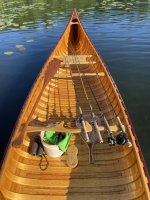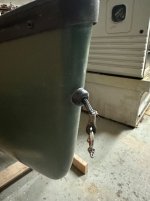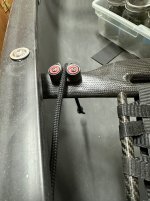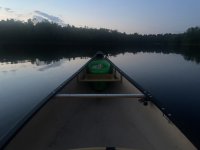I've used my new boat on some fast moving streams. Any advice on minimizing squirliness in the wind and keep her tracking in current? I used a 5 gallon jug (with 3 gallons) up front with my dog. I'm thinking of moving the ballast to the yoke and let the dog ride in front of that (I removed the "stern" seat). I want to track better downstream and be able to fish without getting into a uncontrollable spin if I take my eyes off the road for a minute. With the ballast closer to the middle I can move it fore and aft to experiment. The dog is not as adjustable long term.
-
Happy New Year 2026! 🕛🍾🥂
You are using an out of date browser. It may not display this or other websites correctly.
You should upgrade or use an alternative browser.
You should upgrade or use an alternative browser.
Ballast for Wind, Current
- Thread starter Black_Fly
- Start date
I assume your Prospector's significant symmetrical rocker will make it a turny canoe even if trimmed perfectly with ballast. Not being a fisherman, I don't know how I would keep paddle control of direction while handling a rod.
How about just bottom anchoring periodically to fish, and letting the canoe swing into a fixed downstream position on the anchor line in the current.
Or maybe dragging something like drogue chute would keep the canoe straight.
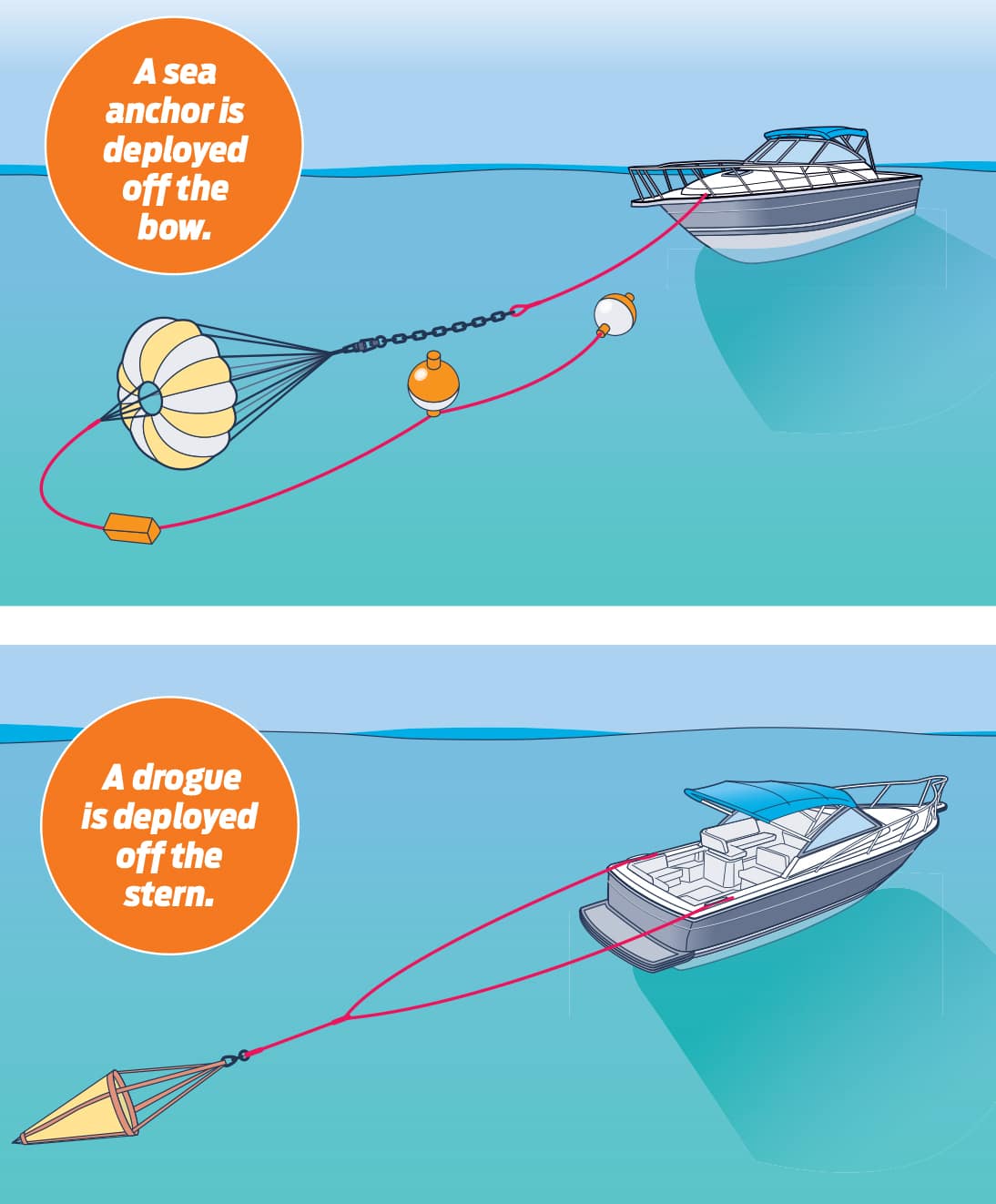
 www.boatingmag.com
www.boatingmag.com
How about just bottom anchoring periodically to fish, and letting the canoe swing into a fixed downstream position on the anchor line in the current.
Or maybe dragging something like drogue chute would keep the canoe straight.

How to Use Drogues and Sea Anchors | Boating Mag
Scenarios which a drogue or a sea anchor might prove useful, and how to deploy one.
- Joined
- Aug 10, 2018
- Messages
- 2,072
- Reaction score
- 6,908
In the past, I've been successful in slowing the drift (for fishing) by dragging a heavy length of chain behind the boat but you'll have to paddle upstream whenever it gets snagged.
I use a panic snap within easy reach at the canoe and I have a float on the rope so the chain can be recovered in the event that it needs to be cut loose in a dicey situation.
The only way I can think of to decrease squirliness is to increase the load. Can you overfeed yourself or the dog? Maybe take a bunch of beer? (wait... beer might actually INCREASE squirliness depending on consumption levels.)
I use a panic snap within easy reach at the canoe and I have a float on the rope so the chain can be recovered in the event that it needs to be cut loose in a dicey situation.
The only way I can think of to decrease squirliness is to increase the load. Can you overfeed yourself or the dog? Maybe take a bunch of beer? (wait... beer might actually INCREASE squirliness depending on consumption levels.)
For fishing in the canoe you have to let the wind and current dictate how and where you will fish, don't fight it. I mostly fish flat water so wind is the challenge. Knowing which way the wind is blowing and how your canoe will weathervane, you can set yourself up for a drift that will hopefully take you over some fish. In a current you would have to do the same thing except it's more complicated because there is usually also wind. In general though the current will want to push the heavy end of the boat downstream so pointing your bow upstream and drifting backwards might be a solution. You could also adjust your trim to be either bow heavy or at least very flat, I would do this with my body weight by moving forward and back as conditions require. When I'm fishing in an empty canoe I can be anywhere from sitting in the stern seat to kneeling or sitting on the center thwart. I also stand anywhere in the boat I need to for the desired trim.
Or maybe dragging something like drogue chute would keep the canoe straight.

How to Use Drogues and Sea Anchors | Boating Mag
Scenarios which a drogue or a sea anchor might prove useful, and how to deploy one.www.boatingmag.com
I've been thinking about the physics of a drogue or drift sock in river current. Unless it is heavily weighted like Gamma's chain, I'm not sure it would actually provide drag. It might just float along in the current at the same speed as the canoe.
The following video shows how a motor boat fisherman uses a Cabela's drift sock in a slow and deep river current. He bottom anchors the boat at the upstream end and then deploys the drift sock at the downstream end to to provide constant tension on the anchor line, thereby stabilizing the boat against current and wind swirls.
By the way, you can DIY a drogue by punching holes in a cheap five gallon bucket.
Part of the problem with anchors in a canoe is the ends of the boat are not easily reached. I've used the handles to feed an anchor line through, tied to the middle thwart/yoke, but the contact point is not ideal, and retreval is still a pain.
I never use an anchor, mostly for the reasons you mentioned, but also because I like to keep moving. That drift sock idea could also potentially cause a lot of problems. Other than adapting your fishing to how the canoe wants to naturally drift you can try fishing from an eddy or pull out at likely looking spots to fish from shore.
My most important rule for fishing from the canoe is: Don't let the fishing ruin a good paddle. When conditions aren't right for fishing I'll put the rods down before I get frustrated.
My most important rule for fishing from the canoe is: Don't let the fishing ruin a good paddle. When conditions aren't right for fishing I'll put the rods down before I get frustrated.
Part of the problem with anchors in a canoe is the ends of the boat are not easily reached. I've used the handles to feed an anchor line through, tied to the middle thwart/yoke, but the contact point is not ideal, and retreval is still a pain.
When I fished from the canoe (including current) I used a trolley setup for the anchor line. I ran a length of cord from my center seat to the rear carry thwart. This wasn't a straight piece of line that was tied off to either one but rather a loop of line that was tied off to itself. There was a separate little loop in this piece of line that allowed me to clip a carabiner, that was then attached to my anchor line. Think of a clothesline struck across the alley of a 3rd floor apartment building.
So when I was sitting in my center seat the anchor would be at my side and I'd drop it overboard and then pull on the loop of cord so that the anchor attachment point went to the stern of the canoe. When it was time to pull the anchor in I'd pull on the loop of cord so the attachment point came to the center of the canoe where I could reach it.
It wasn't ideal but it worked pretty good.
Alan
Full jug of water up front, cart astern seemed to work well. I switched to a double paddle and it smoothed thing out.
- Joined
- Nov 23, 2024
- Messages
- 3
- Reaction score
- 4
I had a scare last week on the New River in Virginia, USA when a sudden 40 mile an hour wind with gusts that were going different directions slammed me. It was a big challenge to row the 2 miles back upstream to the boat ramp. Keeping my 1952 Grumman pointed into the wind so I wouldn't capsize was very difficult.I've used my new boat on some fast moving streams. Any advice on minimizing squirliness in the wind and keep her tracking in current? I used a 5 gallon jug (with 3 gallons) up front with my dog. I'm thinking of moving the ballast to the yoke and let the dog ride in front of that (I removed the "stern" seat). I want to track better downstream and be able to fish without getting into a uncontrollable spin if I take my eyes off the road for a minute. With the ballast closer to the middle I can move it fore and aft to experiment. The dog is not as adjustable long term.
I'm wondering if a bucket of water in the bow would have helped.
The picture shows the cockpit of my Grumman. Yes, I row it with 2 oars instead of traditional paddling. I believe this oar set up saved my life last week.
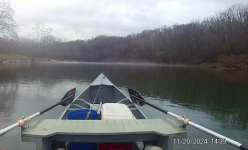

Move your body position in your canoe to account for the wind. For a head wind for instance, you want the weight forward. I use my Border Collie for final trim. I ask her to move and then sit in the right place.
Id not use an anchor on flowing water but for my flat water fish dipping boat i machined a fitting and installed it in the stern and run the line thru, up to my seat; relying on a Harken cleat to secure the end. I don't even look back its that fool proof.Part of the problem with anchors in a canoe is the ends of the boat are not easily reached. I've used the handles to feed an anchor line through, tied to the middle thwart/yoke, but the contact point is not ideal, and retreval is still a pain.
Now of course you'd not want to deface a boat as nice as @lowangle al is showing with such a rube goldberg set up as this. A similar arrangement (strap-on) could be devised with “no drilling involved”.
Attachments
- Joined
- Nov 22, 2021
- Messages
- 379
- Reaction score
- 565
Paddling my North Wind solo on the Green River, when I'd stop paddling, to take a photo or a drink, my canoe would tend to turn sideways or, even, upstream, and be reluctant to get turned back downstream. I attributed that to its asymmetrical rocker, which would lead me to believe adding weight to the bow might help your situation, but it depends on wind. Normally you trim bow heavy with an upstream wind and stern heavy with a downstream wind. I'm wondering how Swede form fits into the equation. That could also make a canoe want to point upstream when not moving forward fast enough.I've used my new boat on some fast moving streams. Any advice on minimizing squirliness in the wind and keep her tracking in current? I used a 5 gallon jug (with 3 gallons) up front with my dog. I'm thinking of moving the ballast to the yoke and let the dog ride in front of that (I removed the "stern" seat). I want to track better downstream and be able to fish without getting into a uncontrollable spin if I take my eyes off the road for a minute. With the ballast closer to the middle I can move it fore and aft to experiment. The dog is not as adjustable long term.
If you get it trimmed correctly, an even current will spin you sideways and you’ll stay sideways down the stream. At least that’s what I noticed. That’s what I try for, not considering wind, which varies in direction and can be adjusted moving weight forward or aft.Paddling my North Wind solo on the Green River, when I'd stop paddling, to take a photo or a drink, my canoe would tend to turn sideways or, even, upstream, and be reluctant to get turned back downstream. I attributed that to its asymmetrical rocker, which would lead me to believe adding weight to the bow might help your situation, but it depends on wind. Normally you trim bow heavy with an upstream wind and stern heavy with a downstream wind. I'm wondering how Swede form fits into the equation. That could also make a canoe want to point upstream when not moving forward fast enough.
- Joined
- Nov 22, 2021
- Messages
- 379
- Reaction score
- 565
I think that's true, but it took more force to get it turned back downstream than it should have, but I think I'd concluded that I also had it trimmed stern heavy in addition to the asymmetrical rocker. I'm thinking that, if I had moved some weight forward, it probably would have handled better. But might not be true for your boat. Might be worth trying, though.If you get it trimmed correctly, an even current will spin you sideways and you’ll stay sideways down the stream. At least that’s what I noticed. That’s what I try for, not considering wind, which varies in direction and can be adjusted moving weight forward or aft.
I used to use rocks. It was handy. I never had to carry anything and would just pick a few up at the put-in and stack them in the stern.
Then someone pointed out that if I were to capsize, and the rocks didn't roll out, that the canoe would likely sink to the bottom.
So I quit using rocks and just carried an empty roll top dry bag that I would fill with water. It was super easy.
Alan
Then someone pointed out that if I were to capsize, and the rocks didn't roll out, that the canoe would likely sink to the bottom.
So I quit using rocks and just carried an empty roll top dry bag that I would fill with water. It was super easy.
Alan
Paddling my North Wind solo on the Green River, when I'd stop paddling, to take a photo or a drink, my canoe would tend to turn sideways or, even, upstream, and be reluctant to get turned back downstream. I attributed that to its asymmetrical rocker, which would lead me to believe adding weight to the bow might help your situation, but it depends on wind. Normally you trim bow heavy with an upstream wind and stern heavy with a downstream wind. I'm wondering how Swede form fits into the equation. That could also make a canoe want to point upstream when not moving forward fast enough.
Quite often, it's easier to get a canoe pointed back downstream by edging the boat to the downstream side and doing a back sweep on that lower side. That's because the current helps in carving an upstream turn. To turn downstream with a forward sweep, you have to outrun the current.
Similar threads
- Replies
- 12
- Views
- 2K
- Replies
- 8
- Views
- 1K
- Replies
- 10
- Views
- 724

